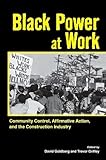Black Power at Work : Community Control, Affirmative Action, and the Construction Industry / ed. by Trevor Griffey, David Goldberg.
Material type: TextPublisher: Ithaca, NY : Cornell University Press, [2011]Copyright date: ©2011Description: 1 online resource (280 p.)Content type:
TextPublisher: Ithaca, NY : Cornell University Press, [2011]Copyright date: ©2011Description: 1 online resource (280 p.)Content type: - 9780801461958
- Affirmative action programs -- United States
- Affirmative action programs -- United States
- African American construction workers
- African American labor union members
- Black power -- United States
- Civil rights movements -- United States
- Construction workers -- Labor unions -- United States
- Construction workers -- Labor unions -- United States
- Labor movement -- United States
- Labor History
- U.S. History
- POLITICAL SCIENCE / Labor & Industrial Relations
- 331.6396073
- HD9715.U52
- online - DeGruyter
| Item type | Current library | Call number | URL | Status | Notes | Barcode | |
|---|---|---|---|---|---|---|---|
 eBook
eBook
|
Biblioteca "Angelicum" Pont. Univ. S.Tommaso d'Aquino Nuvola online | online - DeGruyter (Browse shelf(Opens below)) | Online access | Not for loan (Accesso limitato) | Accesso per gli utenti autorizzati / Access for authorized users | (dgr)9780801461958 |
Frontmatter -- Contents -- Acknowledgments -- Introduction: Constructing Black Power -- 1. "Revolution Has Come to Brooklyn": Construction Trades Protests and the Negro Revolt of 1963 -- 2. "The Laboratory of Democracy": Construction Industry Racism in Newark and the Limits of Liberalism -- 3. "Work for Me Also Means Work for the Community I Come From": Black Contractors, Black Capitalism, and Affirmative Action in the Bay Area -- 4. Community Control of Construction, Independent Unionism, and the "Short Black Power Movement" in Detroit -- 5. "The Stone Wall Behind": The Chicago Coalition for United Community Action and Labor's Overseers, 1968-1973 -- 6. "The Blacks Should Not Be Administering the Philadelphia Plan": Nixon, the Hard Hats, and "Voluntary" Affirmative Action -- 7. From Jobs to Power: The United Construction Workers Association and Title VII Community Organizing in the 1970s -- Conclusion: White Male Identity Politics, the Building Trades, and the Future of American Labor -- Notes -- About the Contributors -- Index
restricted access online access with authorization star
http://purl.org/coar/access_right/c_16ec
Black Power at Work chronicles the history of direct action campaigns to open up the construction industry to black workers in the 1960s and 1970s. The book's case studies of local movements in Brooklyn, Newark, the Bay Area, Detroit, Chicago, and Seattle show how struggles against racism in the construction industry shaped the emergence of Black Power politics outside the U.S. South. In the process, "community control" of the construction industry—especially government War on Poverty and post-rebellion urban reconstruction projects— became central to community organizing for black economic self-determination and political autonomy.The history of Black Power's community organizing tradition shines a light on more recent debates about job training and placement for unemployed, underemployed, and underrepresented workers. Politicians responded to Black Power protests at federal construction projects by creating modern affirmative action and minority set-aside programs in the late 1960s and early 1970s, but these programs relied on "voluntary" compliance by contractors and unions, government enforcement was inadequate, and they were not connected to jobs programs. Forty years later, the struggle to have construction jobs serve as a pathway out of poverty for inner city residents remains an unfinished part of the struggle for racial justice and labor union reform in the United States.
Mode of access: Internet via World Wide Web.
In English.
Description based on online resource; title from PDF title page (publisher's Web site, viewed 26. Apr 2024)


